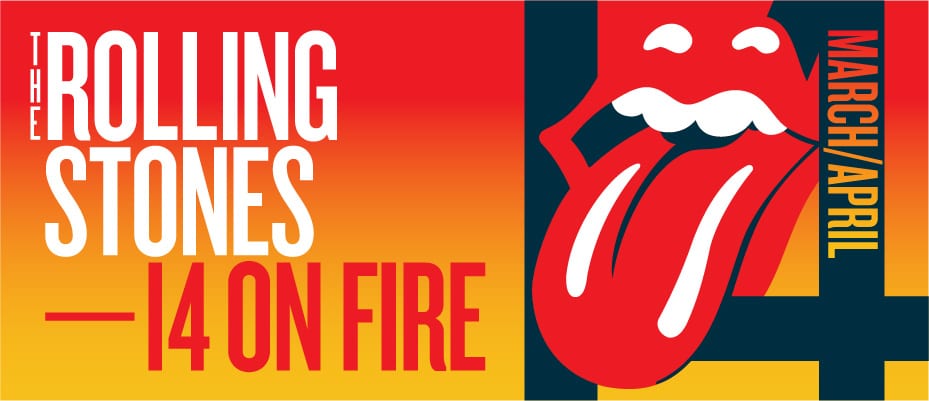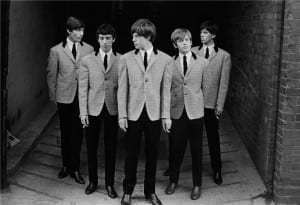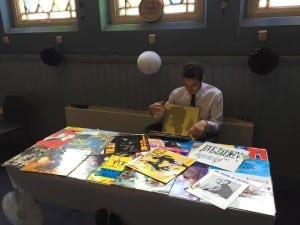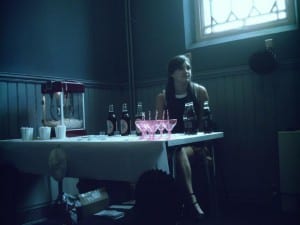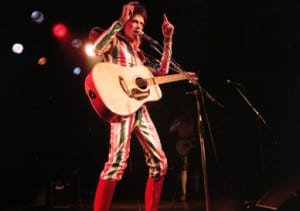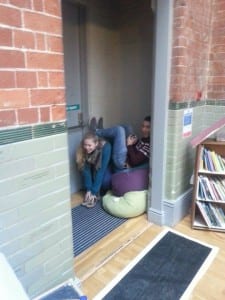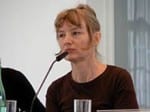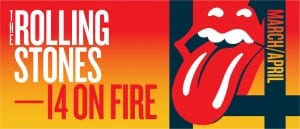Midnight Rambler: Final Blog Post – Sean Micallef
Midnight Rambler was performed at the Lincoln Drill Hall on the 8th May 2015 by Charlotte Fage, Mary Harris and I. The piece was a memorial, interactive performance, inspired by the history of the Drill Hall, and more specifically the history of the ‘Blue Room’ located at the back of the Drill Hall, which we learnt was formerly the box office many decades ago. We combined the history of the room with the history of the building to recreate the box office on the night that The Rolling Stones played the Drill Hall, the 31st December 1963. We chose to do this as we felt that a lot of the other groups were focussing on some of the darker history of the Drill Hall, mostly to do with the war or the typhoid epidemic for example, thus we decided to look into some of the brighter history, which led us to the Rolling Stones playing on New Years Eve, as this is more of an inspiring occasion. Our piece was also largely influenced from personal experiences, which stemmed from us reaching out to the general public, via newspapers and social Medias as well as word of mouth, which led us to some detailed stories.
We redecorated the room, in an attempt to bring the room back to 1963, with the use of some 60’s party decorations, 60’s clothing and hair and make-up. We also attempted to stimulate the senses through taste, sound and smell, to recreate an aura of the 1960s, using a long running live performance from the Rolling Stones through some speakers, a popcorn machine, glass bottles of coke, as well as Newcastle Brown Ale, as it fitted with one of our stories, . There was also I also acquired a collection of vinyl records to add to authenticity, along with using an abundance of hairspray and constantly set off party poppers symbolising midnight and adding to the smells in the room. The performances were roughly 10 minutes long, running with 15 minute intervals, as we overlapped with another group. We decided on a maximum of 3 audience members, as the space was quite small and intimate, and also this meant that conversations could flow easier, and be less complex with fewer audience members to respond with their own thoughts, feelings and experiences.
We decided to attempt to make our piece an informal and relaxed environment, by beginning with offering the audience members some refreshments in the form of coke and popcorn, and offering to take their coats and etc. to simulate an intimate box office, as well as relaxing the audience. The premise of our idea was that the audience would resemble the audience of the Rolling Stones gig in 1963, and that they had come in to see if there was anyway they could get into the gig, but we couldn’t allocate more tickets until people had left. They were then invited to wait and countdown to midnight with us, setting off more party poppers, before leaving.
Our idea developed and changed a lot to become the final piece it was. Our original idea was based around the first opening of the Drill Hall on the 24th May 1890, after researching the architectural history of the building, discovering that the site was originally a Saw Mill, before the Drill Hall was there. It was opened by Joseph Ruston, as he donated the £10,000 worth building to the city, with the original purpose of being a social club for his workers, but was open to any use necessary. The building became then used a military and police training facility, and eventually a barracks for the 4th Battalion of the Lincolnshire Regiment during the First World War On a visit to the Lincoln Archives, we discovered a rather hefty newspaper article, which described the lengthy opening ceremony, and as it was older, it was almost a transcript of the day’s events, describing every speech and every action. This inspired us to attempt some kind of recreation performance similar to the work of Iain Forsyth and Jane Pollard, more specifically A Rock ‘N’ Roll Suicide, which was an exact recreation of David Bowie’s final ‘farewell’ performance as ‘Ziggy Stardust’, combining authenticity, nostalgia and contemporary culture (Forsyth and Pollard, 2012).
We toyed with the idea of an exact recreation of the opening ceremony, in the same manner than Iain and Jane did, however we felt that this was not feasible, with our time span and budget. We then thought about attempting to write some form of script, based on the newspaper article I mentioned earlier, and I began to write this script. However, we then decided that this would be far too performance based, and would lose some of its site specificity, as this could essentially be performed anywhere and it would still make perfect sense.
We then did some more research and came across a group called Rotozaza and their two performances; Etiquette and Guru Guru, but predominantly Etiquette. They specialise in using headphones to tell a story and transport the audience to another dimension, more specifically in Etiquette, they transport two people in a public place, usually a café or bar to a theatre or a totally different dimension, the headphones also dictate different instructions for the audience to do, making them become the performers as well as the audience. “Etiquette exposes human communication at both its rawest and most delicate and explores the difficulty of turning our thoughts into words we can trust. A young girl and an old man lead the participants into several micro-situations, often borrowed from film or theatre, wherein the private worlds shared between two people split and reform incessantly.” (Rotozaza, 2007) We played with the idea of using headphones to instruct the audience to do certain things in fitting with the opening ceremony. However this idea was totally abandoned, due to the difficulties of recreating the meal that was produced on the original opening ceremony, as it was far too complicated, so we tried to blend it with the present day, using the food that the current café serve, however this was deemed not sensible and thus the idea was abandoned.
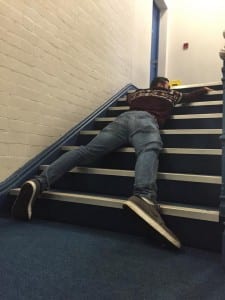
Our final idea was firstly inspired by the room that we had been rehearsing in; called the ‘Blue Room’, which we found ourselves in after doing a ‘noticing unnoticed spaces’ exercise, in which we had to distort our bodies to fit in irregular spaces, and then recreate these distortions in different spaces. We started to think about the former use of the ‘Blue Room’ as it is currently used as a dressing/storage room, as it is, at present, behind the stage. However, the layout of the Drill Hall has changed, and the auditorium has been reversed to accommodate for a café/bar, lessening the size of the auditorium and swapping the back door and the front door of the building, so that the large wooden doors that were the front entrance of the building is now the back entrance. As the ‘Blue Room’ is immediately on the right from entering in these doors, we wondered what the room would have been used for previously, as we were aware of other rooms, such as the basement, being used as a kitchen and the Morris tubes being used for an indoor firing range, in the days of the war. After speaking with one of the members of staff at the Drill Hall, we learnt that the room would have formerly been the box office. We were already aware of some of the buildings former uses, such as a roller disco and wrestling arena, as well as playing hosts to several well-known bands; one of these being The Rolling Stones. We combined these two factors to develop the idea of recreating the box office on the occasion of one of these performances, and we decided to focus on The Rolling Stones, as we felt that they were the most famous band to have played there. This all came after inspiration from Iain Forsyth and Jane Pollard’s A Rock ‘N’ Roll Suicide, to make a recreational performance of the Stones, but again we decided that the idea was not specific to the site.
We were unsure of how top recreate the room, whether to simply put it back into 1963, and act as if we were physically there and treat the audience like they were audience at the actual concert, however, this would mean that we would have to become characters from 1963, and we felt that this would become too performative and we would diminish from site specific performance. We thought that it would be best to juxtapose old and new, slipping between reality and history; talking as if we were in 1963, but then later bringing the audience back to reality stating how we spoke to people that were at the actual event in 1963. This was to blur the lines of reality, making the audience question whether they were being brought back into the 31st December 1963, through the sensory experiences, but then also speaking as if we were in the present day. Miwon Kwon states, when talking about the site that if it becomes “…more autonomous and self-referential, thus transportable, placeless, and nomadic, then site-specific works,” (Kwon, 2004, 11).
This idea was inspired by Janet Cardiff’s Forest, in which she brings audience members into a clearing of a forest or woodland area, seating them, facing different directions, on tree stumps, with speakers dotted around the area. These speakers play a variety of different sounds and noises, in order to blur the reality of the location, for example, playing the sound of gun shots and explosions, in attempt to simulate a war zone, which fits the location perfectly, but is more obvious that it is not in fact reality. Other sounds included wind and footsteps, which are easier to imagine, and can mess with the idea of reality. This also transports the audience from a place of quiet and serenity, with birdsong and wind noises, to a place of destruction and chaos, with the gunfire and explosions. This is what we wanted to do with our piece, slipping between realism and historical realism, although not quite to the extremities that Janet Cardiff went to.
This allowed for an unexpected audience response, in the hope that different audience members would respond to this differently, some embracing the old antiquity, some favouring the present day and others were mixing between the two. As our piece was very conversational and interactive, our aim was to remove the audience from feeling like ‘audience’ as they would watching a play at a theatre for example, as “Audience need not… consider themselves, as ‘audience’…All three sets of relationship, performer/performer, performer/spectator and spectator/spectator, become part of an active matrix of interaction and available for negotiation: momentary and durable, individual and collective.” (Pearson, 2010, 175) It also allowed for the audience to share their own memories and thoughts on the event and the building, as it was so informal and conversational, one example of this being that one audience member shared her memories of coming to the Drill Hall as a young girl, describing her memories of the physical architecture of the building, which as I have previously stated, has changed dramatically.
We felt that focusing on the senses, was extremely important, as “The perception of taste, smell, sound, touch and vision will serve as a framework with which to understand the ways in which artistically meditated environments influence a spectator’s perception of an event.” (Di Benedetto, 2007, 124) Therefore we felt that to continue to blur the lines of reality, as I mentioned above and heighten the experience for the audience, by transferring their senses to something that would perhaps be similar to the 1960s, not only sight, but smell and taste were extremely important in our process.
We were originally unsure of what smells and tastes to use to bring the audience into 1963, the scent of cigarettes was one of the first ideas that we had, as a large majority of people in the 1960s smoked indoors and especially at events such as music gigs. However, this was a difficulty, as we could not smoke on the premises; we thought about cigarette smoke covered coats on the coat rack, but in the end we decided to use a variety of other smells to stimulate the senses. We used popcorn, as this was heavily advertised in the 1960s and was associated with entertainment, such as theatre and cinema. Coca-Cola was another vital smell, as this was an extremely popular soft drink in the 1960s, and the iconic bottle, was heavily advertised and is seen as almost nostalgic in modern times.
Another smell we used was more specific to our performance and more explicitly, the site, with the hairspray, as the room is currently used as a dressing room, and the smell of hairspray is often related with the backstage of a theatrical performance. As I mentioned previously we used party poppers to celebrate the arrival of midnight, and they have a very distinctive smell, which is often associated with celebrations such as New Years Eve, therefore this was an important element to manipulate the senses. We also thought about using taste, with the popcorn and coco-cola, offering it to the audience, as well as Newcastle Brown Ale, which is talked about by Mary, when talking about her story, which entails Mick Jagger buying 7 bottles of the beer from a local pub.
The decision for our title was also a very tentative one, we decided to look at a list of Rolling Stones songs, and see if anything jumped out at us, we were hoping that we could relate it to either the 1960s or perhaps time or even New Years Eve. We first looked at their first songs released, one of the most famous being ‘I wanna be your man’, which was in fact released in 1963 and coincidentally they also played this song on the 1st January 1964 on the first ever broadcasting of the BBC program ‘Top of the Pops’, which was obviously the day after they performed at the Drill Hall, and was key to their success. However we eventually decided upon Midnight Rambler, as we felt that the title was more relevant to our piece, with New Years Eve and our piece building up to midnight, we also discovered that this song was played 12th on their tour 14 on Fire in 2014, thus we chose this for our title.
In analysing the final performance, it went fairly close to how we intended it to be; one of our slight weaknesses however, was the issue of timing, as we wanted to make sure that we timed it so that we told all of our stories that we had prepared, then Mary leaves to ‘see if anybody had left the auditorium’ so the prospective audience members could get tickets to see the Rolling Stones. However she soon returns stating that this is not possible as nobody has left, this is where we then invite the audience to wait with us to see in the New Year as it is almost midnight. Trying to perfect this timing so that we weren’t left to flounder for conversation for a few minutes was difficult, and we had to tamper with the clock we had to make sure we left ourselves the appropriate amount of time for the whole performance.
We had a good number of audience members, with 2 or 3 at every performance, as this allowed for conversation to flow, but also the ability to fully inform our audience as intended. However, each different audience member differed in their responses, as expected, some offering more to the conversation than others, some immersing themselves into the year of 1963, others sharing their memories of the Drill Hall. We felt that when the audience was unresponsive and didn’t offer much to the conversation, it became slightly awkward and uncomfortable though.
In terms of improvements we could make to our performance were we to do it again, the obvious one to us was the collection of the audience. Mary had to collect audience members from the entrance of the Drill Hall at the box office, walking them through the auditorium to the ‘Blue Room’. Although this meant that she could describe the former architecture of the building as I have previously stated, we would ideally have greeted audience from the large back doors, as this was the entrance in 1963 and bring them into our room, and then when escorting the audience out, we would take them through the auditorium, describing the architecture then, and leaving them at the current box office. Unfortunately this was not possible as the audience would perhaps not be able to find their own way to the back doors, and was thus deemed unfeasible.
In terms of what I have left, I would say that the most notable thing and something I have also enjoyed, was researching about the site, especially its architectural history, and previous uses. This is perhaps because “Performance, in turn then, may reveal, make manifest, celebrate, confront or criticise site or location, and the architecture, history, function, location, micro-climate may be appropriate as subject matter, framing and subtext.” (Pearson, 2007)
Reference Lists
Di Benedetto, S. (2007) Guiding Somatic Responses within Performative Structures: Contemporary Live Art and Sensorial Perception. In: Sally Barnes and Andre Lepecki eds. The Senses in Performance. New York: Routledge, 124-135
Forsyth, I. and Pollard, J. (2012) A Rock ‘N’ Roll Suicide. [online] Available from: http://www.iainandjane.com/shows/arocknrollsuicide/ [Accessed 14/05/15].
Kwon, M. (2004) One Place After Another: Site-Specific Art and Locational Identity. London: MIT Press.
Pearson, M. (2007) Site Specific Performance. University of Art and Design, Helsinki, lecture notes.
Pearson, M. (2010) Site Specific Performance. Basingstoke: Palgrave Macmillan.
Rotozaza (2007) Etiquette. [online] Available from: http://www.rotozaza.co.uk/etiquette2.html [Accessed 14/05/15].
